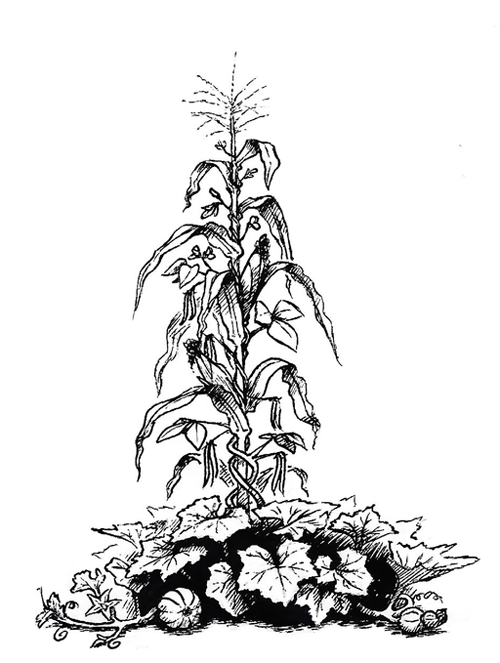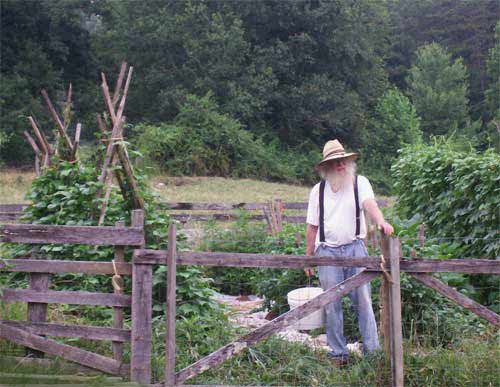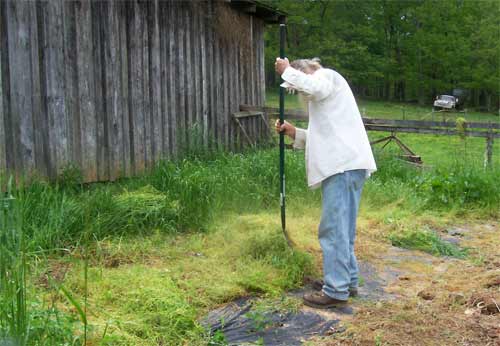
Best vegetables to grow in the North Georgia Mountains
North Georgia covers a lot of territory and contains several growing zones. For now, let's think about growing vegetables in the most northern part of Georgia where elevation is a lot higher than the rest of the state.

Start with some onions
Onions are easy to grow. Start with sets, not seeds and you will find growing onions to be the easiest vegetable of all to grow in north Georgia.
Just pop the little bulbs into your garden soil and in a few weeks, you will have spring onions for your salads. If you don't eat them all, and you keep them weeded, by late summer you will have big onions ready for slicing.
Prepare an onion bed
Work your ground in fall if possible, removing all grass, weeds, rocks and roots. Add some compost or lime if your ground needs it.
Choose red, yellow, or white onion sets. All three grow easily in north Georgia.
Onions are some of the best vegetables to grow in our area because the sets are readily available in stores, they are inexpensive, they are practically pest free, they are drought resistant, they add flavor to your life, and they are one of the healthiest things you can eat.
In north Georgia, onions lead the way.
Onion sets should be planted as soon as possible in the spring. They can take a hard frost without any problems so don't worry about that. Soon you will see green tops reaching for the sun. We have even had onions growing in the snow!
Plant onion sets thick, and you can eat the ones that need thinning as they grow. I like to eat tender Spring onions with all of my meals especially soup-beans and cornbread!
Harvesting slicing onions
Here in Union County, we can start harvesting slicing onions in late July. Be sure to harvest your mature onions before they form seed tops. Once onions bloom, they don't make good keepers and might rot in storage.
Once seed pods form at the top of the onion stalks, I usually leave the onion alone or save the seeds. The white pom-poms are very pretty in the garden and in flower beds.

The Three Sisters
The Three Sisters (beans, corn, and squash) are also easy to grow in north Georgia. Green beans, corn, and squash, grown in the area for centuries, are some of the best vegetables to grow in and backyard on on a homestead.
They provide a lot of good eating, that's for sure. Beans, corn, and squash originate in the Americas, and are well-suited to our humid climate. Known as the Three Sisters, beans, corn, and squash have a long history with Native Americans and early settlers in the southern Appalachians.
These three vegetables are easy to grow and the seeds are readily available. You can find heirloom and newer varieties in garden centers and online.
Our favorites are Silver Queen, Silver King, and Hawkin's Prolific.
Silver Queen and Silver King are sold at most feed and garden stores. You might also like all the really sweet corns like Candy Corn, but it is too sweet for our tastes. We both love the first few bites, but after that it starts to taste too sugary.
Hawkin's Prolific is a white, dent field corn that Tony and his family have grown for a hundred years. It is perfect for corn bread, grits, and animal feed. And yes! It is also good for creamed corn. If you cut it off the cob right, just barely getting the tips of the kernels, then scraping out the mushy juice with the back of your knife, you will have some wonderful creamed corn. All you add to it is butter, salt, and some water if it gets too thick. You must use a thick bottomed pot for homemade creamed corn or it will stick.
Tony sells Hawkins Prolific seeds in our Every Green Herb store. 175 seeds will produce at least 300 ears of corn if it likes where it is growing and gets enough water. Some stalks might even have 3 ears. Save those for seed and next year you can plant a whole field of corn.
The Cherokee people taught us about The Three Sisters.
Plant corn seed first. When it is up and about a foot tall, plant beans beside the corn stalks. At the same time, plant squash or pumpkins around the perimeter of the garden. Beans grow up the corn which acts as a trellis and the squash vines cover the ground protecting the soil, smothering out weeds, and conserving moisture.
No need for mulch! The scratchy, tough vines also keep out rabbits and hungry critters. Just like all good sisters, each one looking after the others.
For easy vegetable gardening, start small.
Start small the first year, with three or four things, and add more variety to your vegetable garden as time goes by. It never pays to over plant (although all of us gardeners have done it) unless you are going to hire help later in the growing season.
Planting is the fun part but remember that hoeing a big garden in the Georgia heat is a dreaded chore. Stick to what you can easily handle and your gardening experience will bring joy to your life, along with delicious food to your table.

Most vegetables are easy to grow in north Georgia.
Okra, potatoes, tomatoes, onions, greens, cabbage, cucumbers, peas, melons, and peppers grow well here. When you get right down to it, most popular vegetables grow readily in this area where the soil is rich, the growing season is long, and the weather is temperate.
Since almost all familiar vegetables grow well in north Georgia, let your taste buds decide which ones to plant. Do you love tomatoes but hate green peppers? Then grow more tomatoes and forget the peppers!

It requires some work to grow a garden.
All vegetable gardens require work – even in Georgia. Even though vegetables grow easily in north Georgia, they do not take care of themselves. Preparing the ground, planting, watering, weeding, mulching, and keeping an eye out for pests are time consuming chores that take some time and some energy.
A tiller and lawn mower come in useful. Here on the farmstead, we also have large equipment, but heavy machinery is not used in our vegetable garden because it would compact the soil.
Spring planting is a joy but it is not easy to work in the humid south when temperatures sore into triple digits. Even though northern Georgia and the North Georgia Mountains are known for cool waterfalls, pristine rivers, and green forests, the heat can become unbearable in late July and August.
Take advantage of the shade.
Planting vegetables that tolerate shade make late summer gardening easier. We try to stay in the shade during late summer heat waves and so should you!
Lettuce, beets, and carrots like some shade, and even tomatoes and peppers appreciate protection from late summer sun. Plan to use some shade cloth in your vegetable garden if possible when temps get over 90 degrees Fahrenheit. Your tomatoes and your body will thank you.
Tips for making gardening easier in the North Georgia Mountains
- Have your soil tested and amend it as recommended.
- Make your own compost and add it to your vegetable garden every year.
- Do some research and plant varieties that do well in zones 6, 7, or 8 (depending on if you are in a valley or on a ridge).
- Don't over-plant in spring.
- Keep your vegetable garden as weed-free as possible.
- Water only if needed and use a drip hose if you can. Do not water in late evening, unless you have no other choice.
- Keep an eye out for pests and take measures to get rid of them quickly.
- Avoid all poisonous chemical pesticides and herbicides. Instead, choose organic methods that don't kill bees and beneficial pollinators.
- Use natural fertilizers if possible.
- Harvest and enjoy your bounty. Even in fall when your garden looks overgrown and weary, take a rake and look. You will be sure to find some vegetables hiding in the vines and weeds.
- Be proud that you grew some of your own food! If you have extra, share with neighbors or store for winter use.
- Clean up your garden in the late fall. Put it to bed with a thick mulch of hay, straw, or chopped leaves for the winter. You can also use cover crops to protect the soil during off season.
- Never leave ground bare to the elements. If you don't have straw or leaves, use cardboard, old cotton linens, newspapers, or paper feed sacks. All of these things will decompose over time and actually add to your soil's health.

Use mulch for easier gardening in north Georgia.
Mulch is worth a second or third mention. No matter how easily things grow, you will still have to fight the weeds. Mulch is the best defense!
Vegetables will not produce if grass and other plants take up their growing space. That's were mulch comes in. Mulch helps keep weed seeds from sprouting! If you want an easier time in your vegetable garden, then invest in mulch.
Otherwise, set aside plenty of time for pulling broadleaf perennials, twining vines, and grass from your vegetable beds. If you really want to experience easy vegetable gardening in the North Georgia Mountains, then read on.
Using containers to grow vegetables in north Georgia
Container gardening is the easiest method to growing vegetables! If you can afford quality potting soil, then this is the way to go.
People are growing potatoes in old tires, tomatoes in wooden barrels, and peppers in terra cotta pots. You can use black plastic pots, cement pots, and even old metal pans as containers, but do not skimp on potting soil. Buy the best you can find.
Although it is relatively expensive, I like to use Pro Mix. It comes in black plastic bales and expands when you wet it. No other potting soil comes close to this stuff. Pro Mix is actually sold as seed starter, but it is also wonderful used in container gardening.
Growing veggies in a bag
I also like to grow things with shallow roots like lettuce and spring salad mix in an inexpensive bag of potting soil. Just poke holes in one side of the potting soil bag, put that side down, make slits in the top side, water, and plant your seeds or transplants.
Your greens will never need weeding and they will stay clean and pest free. Growing vegetables can't get any easier than this.
Can I grow exotic vegetables in north Georgia?
Yes! Try rutabagas, Swiss chard, eggplant, bok choy, and all the heirloom vegetables, too. Who knows? You might just find something that becomes a hit in your family.
That's what happened to us with kale. How did we ever live without Chopped Kale and Broccoli Salad with Maple- Balsamic Vinegar Dressing?
Now we keep kale in our garden year round and try to always have it on hand.
Buying young vegetable plants
Sometimes it is easier to buy transplants instead of sowing seeds. This is an easy method to get your vegetables started, in case you have trouble with seeds.
Some vegetables are a lot easier to grow when purchased as transplants from a garden center. We always try to buy several six-packs of cabbage, broccoli, kale, Brussel sprout, and cauliflower plants. Even seasoned farmers can find these seeds hard to sprout. Tomatoes and peppers can also be found in plastic cells, ready for the home garden.
We are able to start tomatoes and peppers just fine from seed, but our cabbage and other cruciferous veggies have always become leggy when started indoors.
Are some vegetables hard to grow in north Georgia?
Well, I have never seen any celery growing in north Georgia, but I think those plants might be difficult to grow no matter where you live. Some seeds such as carrots and beets are harder to sprout than others, but once you get them going, they are not hard to grow.

North Georgia vegetables taste better.
With our unpredictable weather, is it worth the effort to grow vegetables in the North Georgia Mountains? Yes, it is. Here's why.
Vegetables grown in north Georgia taste better than the same varieties grown elsewhere. I think it is due to the minerals in our soil.
Think about it. Those old worn-down Appalachian Mountains have deteriorated a lot over the past million years. All that rock dust and organic matter is in our soil.
You can taste the difference! South Georgia green beans taste bland compared to our green beans. So do their pumpkins, squash, and corn.
Now I will admit, south Georgia has us beat when it comes to peanuts and watermelons, and they produce some amazing sweet onions, but when it comes to most veggies, north Georgia grows the best tasting produce by far. I also want to give a shout out to California and Florida. Thank God for the variety they provide.
In my opinion, Appalachian farmers grow the best tasting vegetables in the world!
Go ahead and start your garden!
Growing vegetables in north Georgia is easy and satisfying. You don't have to have a big vegetable garden to get the benefits of gardening. Even a pot of basil sitting on a windowsill can bring joy to your kitchen and flavor to your tomato sauce.
Go ahead and give gardening a try. Plant some onion sets in April. Plant a small stand of corn at Easter. Add some green beans in late May. Put some of your favorite tomato varieties in large pots or 5 gallon buckets.
When you see how easy it is to grow these vegetables, you will be glad you made the effort.
Happy growing to everyone in north Georgia (zones 6 and 7) and beyond!
Give vegetable gardening a try and feel free to email me with any questions. Thanks for reading my blog, Jan.
Back to list of blog posts
To purchase heirloom corn seed, yellowroot, and other herbs, visit Every Green Herb (our herbal encyclopedia and online store).
Contact us by email at hometown30512@yahoo.com
Payne Mountain Farms
322 EV Farm Dr.
Blairsville, GA 30512 USA
This post contains original photos, text, and other content by Janice Boling. If stock photos are used, credits are given. Sources are also listed when applicable.
© 2010 - 2023 by Janice Boling